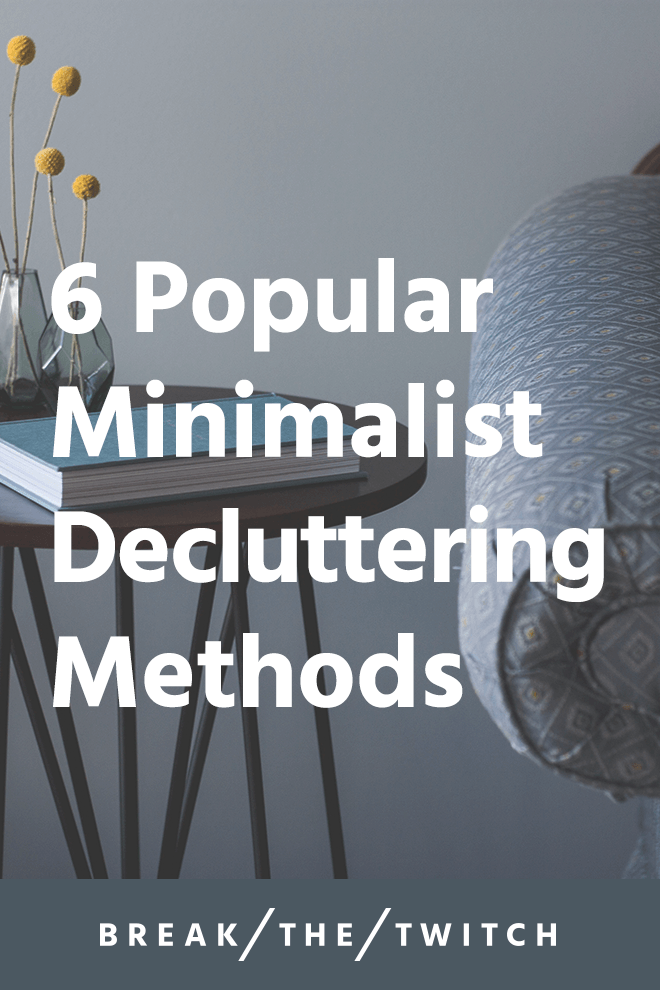The thought of living with less clutter is appealing to many and the benefits are well-known—but most of us aren’t aware of the many decluttering methods.
Owning less stuff means having more time for the most important aspects of our lives. It creates more space and ease in our homes. As desirable as those results may be, the thought of decluttering a home can be overwhelming with a lifetime of stuff collected in basements and closets.
While minimizing will likely require significant time and effort, having some good decluttering methods up your sleeve can make all the difference.
It wasn’t until Amy and I found a decluttering method called The Minimalist Game that we started making consistent progress towards getting rid of the clutter in our lives.
It can be intimidating to know where to start, but choosing one of these six popular decluttering methods can help.
Whether you’re new to minimalism or looking for ways to further your minimalist lifestyle, these methods below are frameworks to help guide you.
If you prefer video, click play on the video below or click here to watch on YouTube. Otherwise, read on!
1 / KonMari Method
This method was made popular by Marie Kondo, the author of The Life-Changing Magic of Tidying Up, and is arguably one of the most well-known decluttering methods out there. With over four million book copies sold, it’s no surprise that her method has gotten so much attention.
Basics: The core principle of the KonMari method is that instead of deciding what to get rid of, you choose what to keep and declutter the rest. To get started, collect every single item you own in a particular category and put them in a big pile. For example, get every t-shirt that you own and put them on the bed. Hold, feel, or wear each one so that you can get a good sense of how it makes you feel. While doing this, ask:
Does this (shirt) spark joy in my heart?
Pros: This decluttering method is incredibly thorough, and allows you to compare all items of a similar type. By doing this, you are able to get rid of any duplicates and compare less-liked items to better ones you may have. It’s an effective way to make a lot of progress decluttering in specific categories across multiple areas of the house at once.
Cons: The KonMari method is time-consuming and requires sorting through an entire household of stuff. Instead of focusing on a room or two, you’re pulling things from the entire house so it has the potential to completely uproot your home.
2 / Minimalist Game
Introduced by Ryan Nicodemus and Joshua Fields Millburn of The Minimalists, this is a method that gamifies the decluttering experience. It’s a popular decluttering method with hundreds of people using the #minsgame hashtag on social media every month.
Basics: Beginning on the first day of a month, the number of things you declutter corresponds to the day of the month. One item on the first day, two items on the second day, three on the third, and so on. By the end of a 31-day month, you will have removed 496 items from your home if you play all the way through. This game works best when you challenge a friend or family member and see who can keep going the longest.
Pros: After a month, you will have decluttered of a ton of stuff! Removing almost 500 items from your home is no small feat, and you can play as many months in a row as you’d like. Another important aspect of this decluttering method is that it starts small and increases over time. This allows you to build confidence in your decision-making abilities and get increasingly better letting go of stuff.
Cons: A major downside of minsgame is that you have to stay consistent each day otherwise it’s easy to fall behind. Much like Tetris, the difficulty increases each level, and it can also be difficult to keep up if you’re inconsistent. Towards the end of the month, you’ll need to find a good number of items each day. After a long day of work, the last thing you may want to do is find 25 items to declutter that day.
3 / Four Box Method
This method is a flexible way to deal with all the items cluttering up your home for however long and whatever frequency you prefer. By sorting the clutter into four categories, you’ll make a decision on every out-of-place item.
Basics: Set up four boxes in a room and label them: Put away, Give away, Throw away, and Undecided. Pick up clutter in the room and place it into one of the four boxes. Then process each box according to the name. This version allows for some flexibility by using the Undecided box if you’re not sure what to do with a particular item yet. Another variation of this method without the Undecided box can be found from Joshua Becker on Becoming Minimalist.
Pros: This decluttering method is straightforward, and there’s a category for everything. Instead of getting stuck on an item, items in the Undecided box can be reconsidered at some future date. It allows you to be flexible and declutter at your own pace.
Cons: The Undecided box can become a problem if too many things start to pile up in it. It’s best to avoid using this box as much as possible and only put in things you’re really unsure about.
4 / One Method
Basics: This method combines other similar philosophies into a simple concept: get rid of one thing every single day for a period of time. That thing can be literally one item, one filled box, or one filled bag per day.
Pros: The One Method really helps to build a habit of decluttering. By getting rid of an amount every single day, you’re able to build decluttering into your daily routine. Another major benefit is the flexibility to create your own system. You can choose your level for each day depending on how much you need to declutter.
Cons: It may be difficult to maintain consistency with a busy schedule or when you’re traveling. This also wouldn’t work well for people who prefer to declutter in big bursts versus small steps each day.
5 / Packing Party
Another decluttering method from The Minimalists, this is a fairly extreme method for decluttering your home, and more likely to be used if you’re already planning on moving to a new home. While it takes a ton of preparation and work, it can be quite effective if you go through with it.
Basics: Have some friends over and pack everything you own into boxes as if you were moving. Throughout the next few months, only take out the items you use. Any items left inside the boxes after three months can be sold or donated.
Pros: This is one of the more extreme and labor-intensive decluttering methods. The Packing Party will help you get rid of whatever you don’t use. Things out of sight are generally out of mind, so you likely won’t even miss what’s in the boxes. This method is fantastic if you already happen to be moving. At your new home, only take out the things you need to use instead of unpacking everything right away.
Cons: This method probably doesn’t make a lot of sense to do unless you are already packing up for a move. Not only will it take a significant amount of time and energy, there’s also the cost of purchasing boxes if you don’t already have them. This method also doesn’t work well for seasonal items or items only used a couple times a year.
6 / Closet Hanger Method
Oprah brought a lot of attention to this method as another effective way to figure out what clothing and other items you actually use. With this method, you can track exactly what’s been used, a few pieces at a time.
Basics: Per the name, this works best for clothing stored on hangers in your closet (duh). The most important thing is to ensure all hangers are facing the same direction when you begin. Each day, you place whatever you wore back in the closet with the hanger facing in the opposing direction to signify what pieces you used.
Pros: This decluttering method is easy to implement and takes almost no time to get started. It’s also a clear-cut way to see exactly what you’re using and what you’re not. The same method can be applied to things outside of clothing, but you’ll need to come up with a way to mark what items are used.
Cons: The Closet Hanger method doesn’t work well for clothing folded in a drawer or on a shelf. It also doesn’t work well for non-clothing items. It can also be easy to forget to put the clothing item back on the hanger facing the appropriate way. And similarly to the Packing Party method, this method doesn’t work well for seasonal or infrequently used items.
Whichever decluttering method you choose, getting started is the most important thing. Life does get better beyond the constant stress of clutter, it just takes some time and effort to get there. If you found this post helpful, check out this intentional decluttering guide for what to do with your decluttered things.

